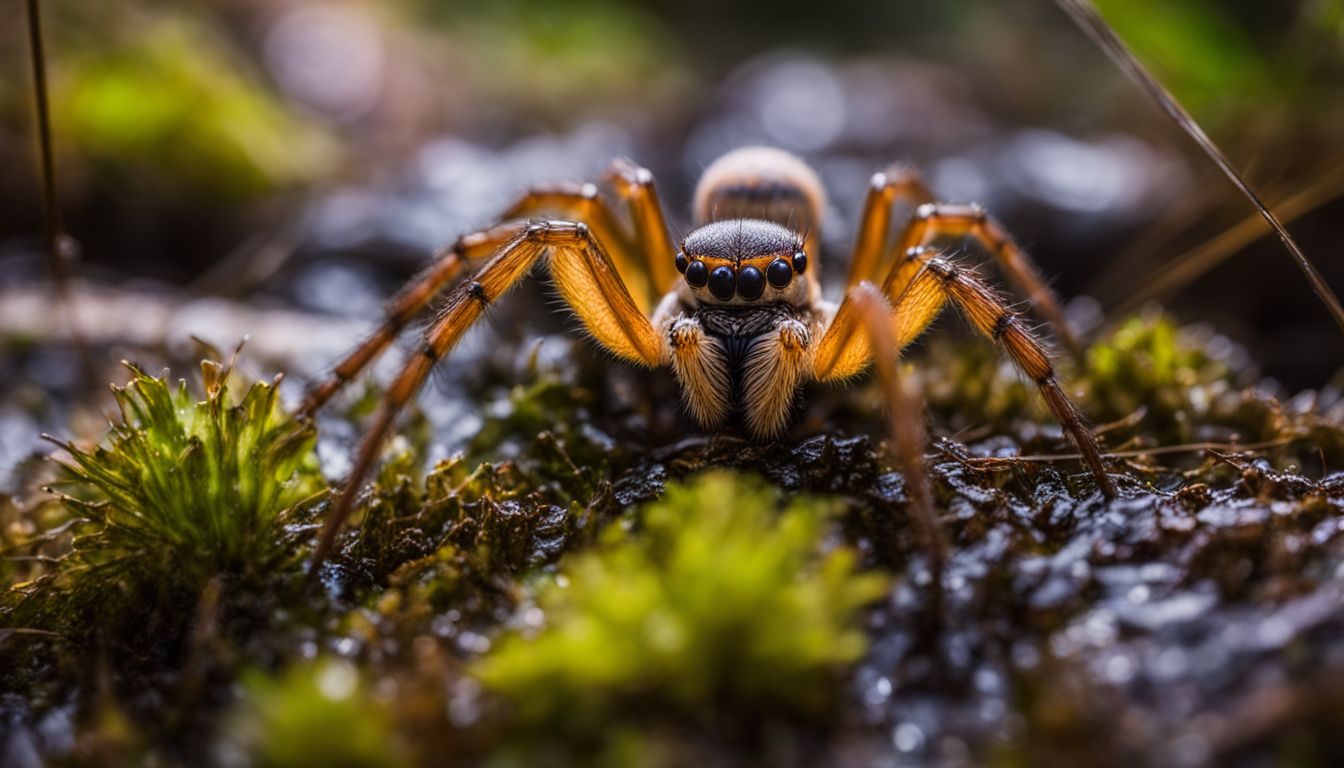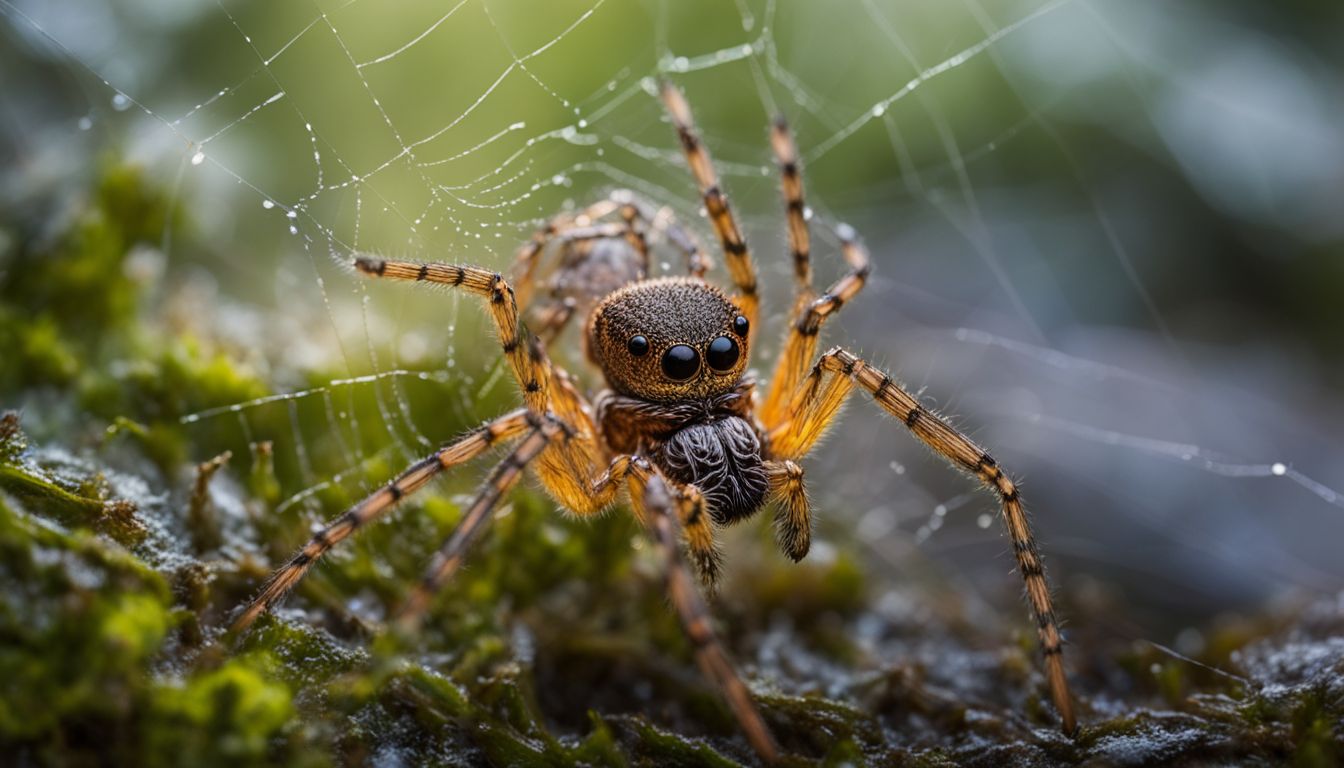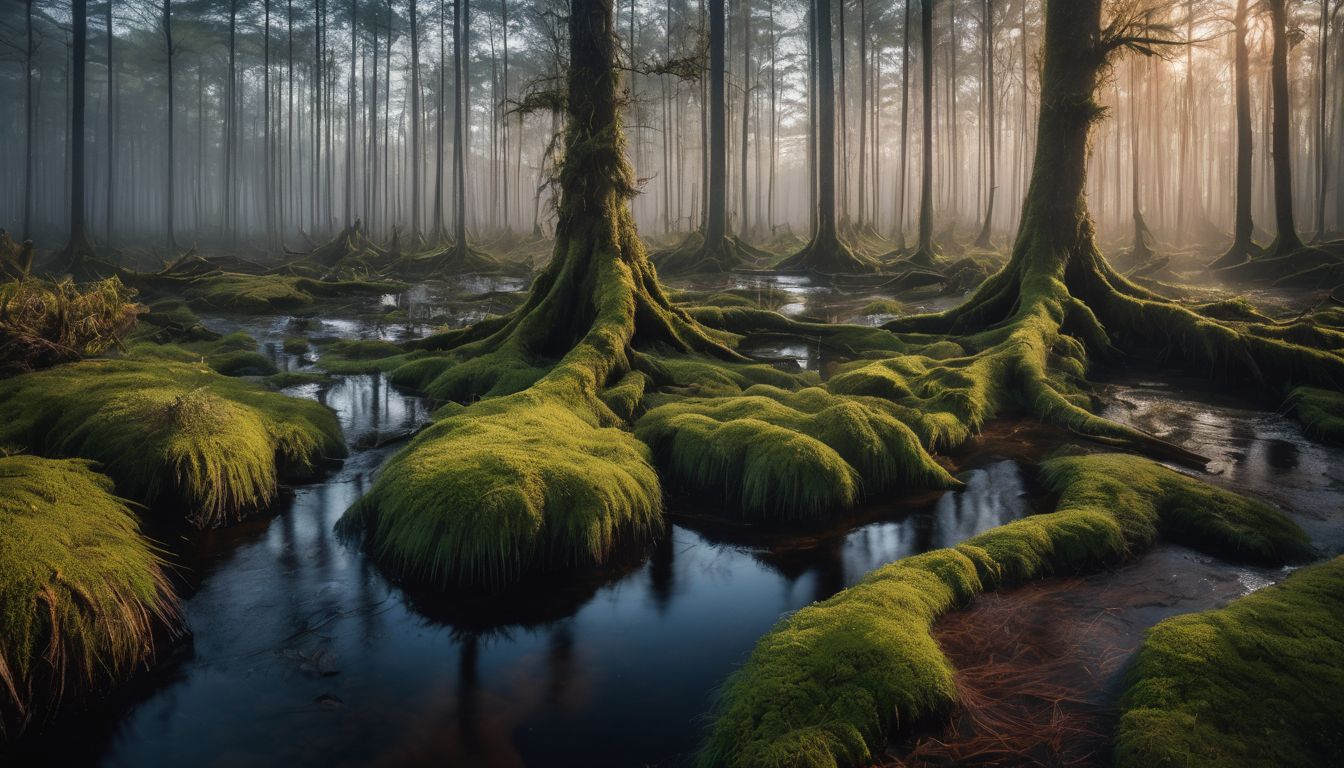Have you ever wondered about the tiny creatures that live among the mossy and mist-laden world of bogs? Bog spiders are fascinating arachnids, perfectly crafted for life in wetland ecosystems.
In this post, we’ll explore these mysterious eight-legged inhabitants and reveal their crucial role in maintaining the delicate balance of nature. Discover a hidden realm teeming with life—let’s dive into the bog!
Key Takeaways
- Bog spiders are fascinating arachnids that thrive in wetland ecosystems, playing a crucial role in controlling insect populations and maintaining the delicate balance of nature.
- Conservation efforts are essential to protect bog spiders from habitat loss caused by human activities such as agricultural expansion and wetland destruction.
- Understanding the hunting techniques and survival strategies of bog spiders sheds light on their vital role in their ecosystems.
Understanding the Habitat: The Unique World of Bogs

Bogs are special places where bog spiders make their homes. They love the wet, spongy ground filled with mosses and plants that you don’t find anywhere else. The water in bogs doesn’t move much, so it’s like a big, still bath for all sorts of interesting little creatures.
In these cool spots, many tiny bugs and plants live together in ways that help each other out. It’s like a secret club where everything works just right to keep life going strong. Bog spiders fit right into this world because they eat some of the insects that also call the bogs home.
This makes them an important part of making sure bogs stay healthy and full of life!
Identifying Bog Spiders: Characteristics and Species
 Bog Sun-jumper Spider in a lush, damp bog.” title=”A close-up photo of a Bog Sun-jumper Spider in a lush, damp bog.” class=”awimage” />
Bog Sun-jumper Spider in a lush, damp bog.” title=”A close-up photo of a Bog Sun-jumper Spider in a lush, damp bog.” class=”awimage” />
Bog spiders come in various species, each with unique characteristics. For example, the Bog Sun-jumper Spider is known for its ability to leap long distances, while wolf spiders are commonly found in cranberry bogs.
The Bog Sun-jumper Spider
The Bog Sun-jumper Spider stands out with its bright green legs. You can find this little creature in nature reserves, especially where there are lots of cranberries. They belong to a spider family known for having long spinnerets that stick out from their back end and special eye patterns.
These spiders are really good at hiding and jumping out to catch bugs to eat. They’re not just great hunters; they also look amazing. Each one has different colors that help them blend into the bog plants and ground.
Sadly, you don’t see them very often because they are rare. But if you ever spot one during a walk in a wetland area, take a moment to watch how it moves so quickly and quietly after its prey!
Wolf Spiders in Cranberry Bogs
While the bog sun-jumper spider leaps after its prey, wolf spiders in cranberry bogs use a different approach. These wolf spiders are big and quick. They run down their meals instead of jumping.
Crawling through the thick plants, they hunt for insects that might harm the cranberry crops. Wolf spiders do an important job here.
Farmers who work with cranberries know these spiders well. People often fear them because of their size and speed, but they help more than they scare. By eating harmful bugs, wolf spiders keep the plants safe and healthy without any need for chemical pesticides.
This makes sure that we can enjoy tasty cranberry sauce without worrying about pests!
The Role of Bog Spiders in Ecosystems
Bog spiders play a crucial role in ecosystems by controlling insect populations, acting as natural pest controllers. They also serve as an essential food source for other animals in the ecosystem, contributing to the intricate web of life.
Bog spiders demonstrate adaptability by resorting to cannibalism when food is scarce, showcasing their vital role in maintaining balance within the ecosystem. Their complex interactions with the environment make them a subject of fascination for researchers and highlight the importance of conservation efforts to protect these unique arachnids.
Threats to Bog Spiders and Conservation Efforts
Habitat loss due to human activities, such as agricultural expansion and wetland destruction, pose significant threats to bog spiders, making conservation efforts crucial for their survival.
To learn more about the importance of preserving these unique arachnids, continue reading the full blog!
Habitat Loss and Conservation Strategies
Bog spiders face a serious threat due to the loss of their natural habitat. Human activities like agricultural practices and peat harvesting have led to the disappearance of raised bogs, which are crucial for these unique arachnids.
As a result, bog spiders struggle to find suitable environments for survival and reproduction, making their conservation challenging. Fragmentation of habitats further worsens this situation by isolating spider populations and reducing genetic diversity.
Conservation efforts focus on preserving remaining bog habitats, restoring damaged areas, and raising awareness about the importance of these ecosystems in supporting diverse wildlife.
Fascinating Behaviors of Bog Spiders
From unique hunting techniques to ingenious survival strategies, bog spiders are fascinating creatures with a range of interesting behaviors. Understanding these behaviors can shed light on the important role they play in their ecosystems.
Hunting Techniques and Survival Strategies
Bog spiders are skilled hunters. They use different techniques to catch their prey. Some bog spiders wait for their prey to come close and then pounce on them, while others build sticky webs to trap insects.
These survival strategies help them find food and stay safe from predators.
Understanding these tactics is essential for appreciating the role of bog spiders in ecosystems. It also gives insight into the incredible diversity of hunting methods used by various spider species, showcasing their unique and fascinating behaviors as predators.
Myths and Misconceptions about Spiders (incorporating the internal link here)
Spiders are often mistaken for being highly dangerous, but in reality, most spiders are harmless to humans. Contrary to popular belief, tarantulas are not as deadly as many people think, with only a few species having venom that can cause harm.
Additionally, the idea that daddy-long-legs are extremely poisonous is just a myth; they actually don’t possess venom glands like true spiders. It’s important to understand these misconceptions to appreciate the vital role these arachnids play in controlling insect pests and maintaining balance in ecosystems.
Many myths about spiders stem from fear and misunderstanding—they’re not out to get us!
How to Spot and Safely Observe Bog Spiders
Now let’s talk about how to safely observe bog spiders. When you’re out exploring, keep an eye on the ground and low-lying vegetation near bogs. Look for long, separate spinnerets and unique color patterns to spot bog spiders easily.
Remember not to disturb their habitat or get too close; use a magnifying glass or camera to observe them from a safe distance.
To have a successful observation, venture out during warm weather when spiders are active and look for webs along the water’s edge where these creatures often dwell. You can also check under leaves and rocks in damp areas, but be cautious not to disturb their homes.
By applying these simple tips while observing bog spiders, you can learn more about these fascinating arachnids without causing any harm.
Conclusion: The Importance of Preserving These Arachnids
After learning how to spot and safely observe bog spiders, it’s crucial to understand the importance of preserving these arachnids. Bog spiders play a vital role in their ecosystems by controlling insect populations, and they offer valuable insights into wetland ecology.
Protecting their habitats is essential for maintaining biodiversity and supporting healthy ecosystems. By studying and conserving bog spiders, we can continue to unveil the mysteries of these unique arachnids while contributing to the preservation of our natural world.
)
Spiders do not deliberately try to eat their mates. This myth might come from certain species where males offer themselves as a meal to females after mating, but this is not the norm for most spiders.
Instead of being cannibals, most male spiders prefer to live on and mate with multiple females.
Another common myth is that spiders can see everything clearly. Although they have many eyes, their vision varies between different spider species. Jumping spiders usually have sharp eyesight compared to other types of spiders and use it in stalking and pouncing on their prey with accuracy.
However, not all spiders can see things that are invisible to the human eye.
To learn more about separating fact from fiction when it comes to spider behavior, check out our article on whether mothballs keep spiders away.
FAQs
1. What are bog spiders?
Bog spiders are a type of spider that live in wet areas like where people grow cranberries. They can be found hanging out around water resources during the cranberry harvest.
2. How do bog spiders help farmers?
These spiders eat bugs that might harm crops, so they are good for the agricultural industry. When bogged down places get cleaned up for farming, these spiders work as natural pest control.
3. Can bog spiders survive in water?
Bog spiders don’t live under water but near it. They make egg sacs and molts—their old skins—close to where there is lots of water, like in bogs used by companies like Ocean Spray.
4. Why should we care about bog spiders?
We should care because they help keep bugs away from important food plants without using chemicals. Also, studying them helps us understand more about how all creatures use water and land.




